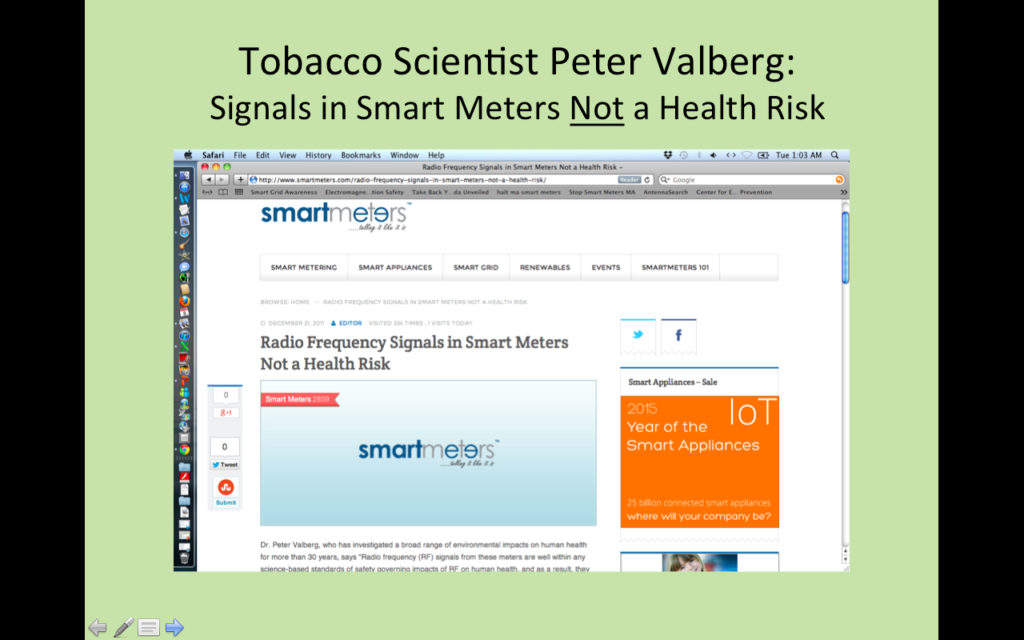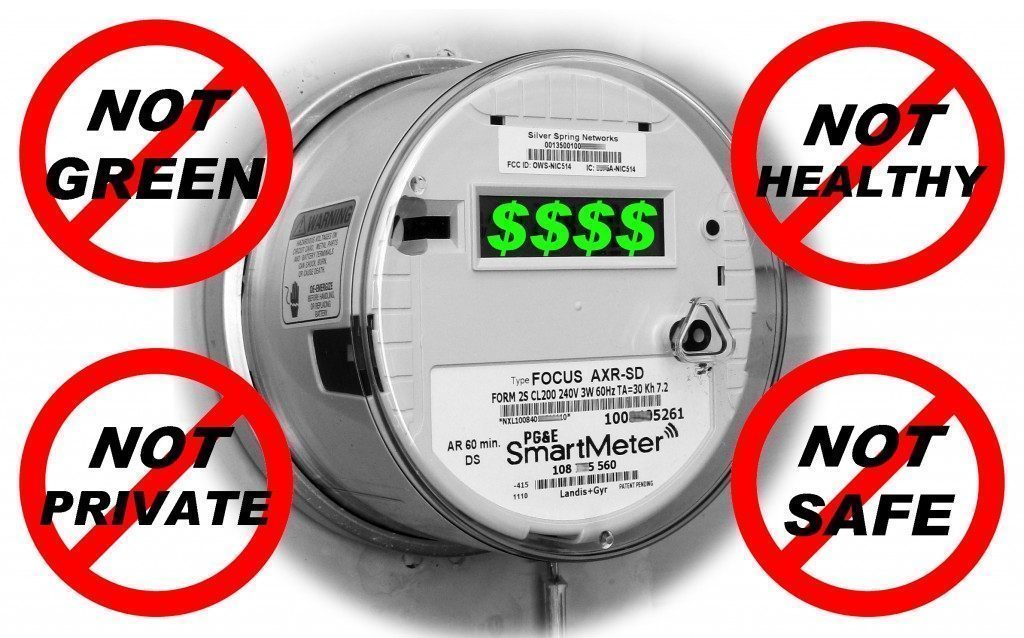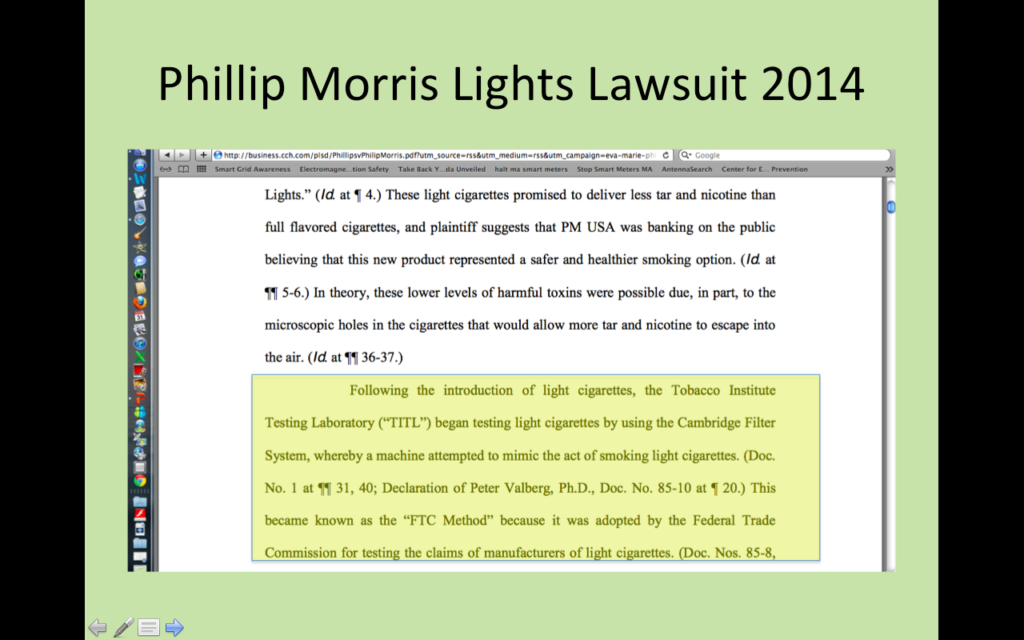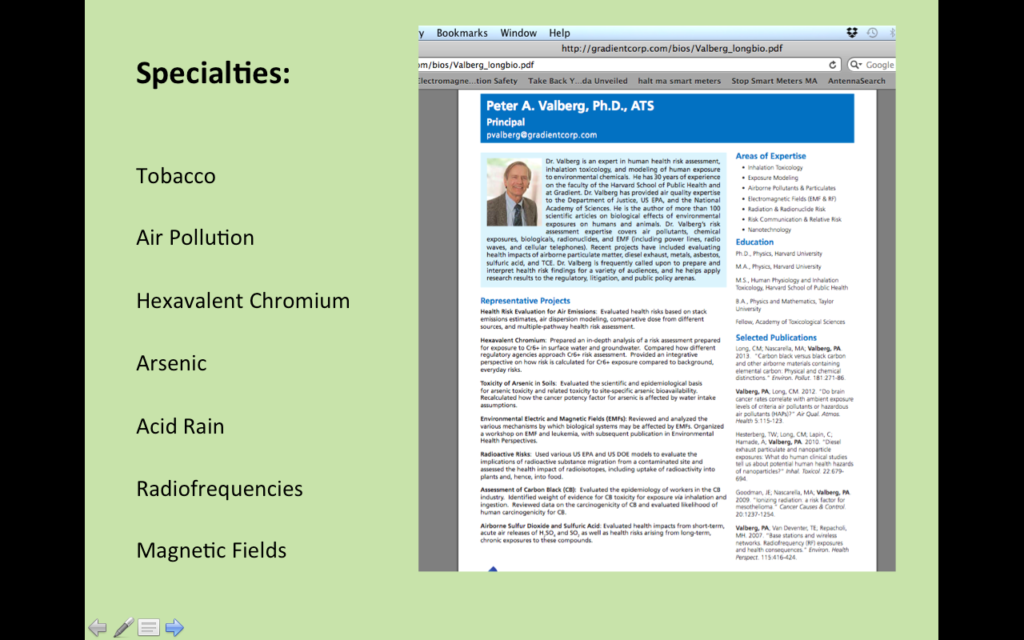In 2009, utilities across the U.S. began installing new two-way wireless electric smart meters on homes. With economic stimulus funding from the federal government, investor-owned utilities were all too happy to have a shovel-ready scheme and a guaranteed rate of return on investment. Citizens were told that the meters would give them “more control over their energy usage.”
Investors were happy, buoyed by state and local regulations encouraging (and in some cases mandating) customers to accept radio-frequency emitting meters for gas, water, and electricity, with additional earnings from the wireless networks that collect the data, software, planned obsolescence, and other growth indicators.
Smart meters appealed to clean energy proponents, too. The narrative is that the meters are necessary in order to integrate more renewables into the grid, particularly solar. To address climate change, or to make electricity more sustainable, or to reduce dependence on fossil fuels, smart meters got hitched to the narrative for solar and other renewables. Approvals for smart meters started sailing through public utility commission hearings across the country, starting in California, Texas, and Maine. Environmental groups including the Sierra Club, National Resources Defense Council, and the Environmental Defense Fund provided compelling testimonies in favor of the grid technologies and smart meters.
When Hurricane Sandy slammed into the New Jersey shoreline in 2012,[1] modernizing the grid became an emergency. Smart meters and a smarter grid were again promoted as a “necessary” response to climate change, and the phrase “hardening the grid” made its way into the parlance of the “robust architecture” of smart meters. Images of the wrath of the hurricane were linked to promises that the smart meters would prevent billions in costs caused by outages.
Illinois was one of the states that established itself as a business leader by promoting smart meters as an economic driver, at one point pushing the math that the grid could be completely modernized for somewhere around $3.00 per month per customer. In 2013, when he voiced concerns for costs to ratepayers, the pro-business Illinois Legislature overrode Governor Pat Quinn’s attempt to veto the deployment of smart meters. [2] He lost his bid for re-election.
The non-profit Smart Grid Consumer Collaborative was eventually formed, and expert analysts published white papers and resources for policy makers. One premise of the Smart Grid Consumer Collaborative’s work is that utilities need to customize their communications with their customers. By watching what was happening in every home and business, utilities would be able to tell individual customers that they needed a more efficient appliance. They could offer customers specific information about how to save energy or money via different rate structures. Utilities implied that customers were driving the demand for the utilities to monitor usage every minute of every day because customers wanted a more intimate and personalized relationship with their electric company.
Currently, smart meters are being portrayed as required to support the adoption of electric vehicles. Also, the time-of-use billing capability enabled by smart meters will now allow utilities to “shave the peak,’ thereby reducing the use of increasingly unpopular gas peaker plants and other “not-clean resources,” and possibly reducing the need to invest in additional generation while allowing the integration of even more “alternative energy.” [3] This scenario has widespread appeal to opponents of gas pipelines and nuclear power.
And, not to be left behind, those who care little for environmentalism but who favor robust economic growth have been buoyed by forecasts of windfalls created by smart meters, a connected economy, and the internet of things. [4]
So, what is not to like?
It turns out – just about everything.
It’s time to break up the forced child-bride marriage of solar to smart meters.
Direct Assaults on Solar
Solar expansion has been stymied by policies including caps on solar,[5] changes in the compensation paid to solar producers who sell electricity back to the grid (net metering), [6],[7],[8],[9] surcharges to solar customers for their use of the grid,[10] favoring large utility-scale solar over rooftop installations,[11] and demand charges.[12]
(Demand charges typically bill consumers for the period of their highest usage —typically monthly. Normally found in the C&I sector, utilities have started proposed demand charges for residential customers, particularly solar. But most of those proposals were rejected, until now.” Massachusetts has imposed a demand charge for Eversource solar customers, penalizing its “prosumers.”) [13]
Direct Assaults on Privacy
When smart meter opponents initially raised the issue of customer privacy, utilities claimed that they were maintaining anonymity by aggregating the data. Some utilizes expressed very little interest in customer data, stating that they only focused on the big picture of what was happening grid-wide.
It turns out that utilities are in fact collecting and storing the personal private consumption details of customers, and ratepayers are bearing the cost of generation, transmission, analysis, and storage of all of that data in air-conditioned storage centers. The Appeals Court in Illinois recently rejected the District Court’s conclusion that granular smart meter data collected every 15-minutes is no different than analog meter readings collected once per month for billing purposes. [14]
While the courts have ruled that a search warrant will be required to obtain records concerning utility usage, [15] the industry is seeking ways to monetize the data. [16] Customers are presumed to have given the rights to the collection of private data to utilities in order to access essential services including water, heat, and electricity.
Direct Assaults on Climate Justice, Human Rights, and Sustainability
In an article entitled “More Recycling Won’t Solve Plastic Pollution” Matt Wilkins explains how “Coca-Cola and Anheuser-Busch, “along with Phillip Morris and others, formed a non-profit called Keep America Beautiful. Its mission was to educate and encourage environmental stewardship in the public. Joining forces with the Ad Council (the public service announcement geniuses behind Smokey the Bear and McGruff the Crime Dog), one of their first and most lasting impacts was bringing “litterbug” into the American lexicon through their marketing campaigns against thoughtless individuals.”[17]
In fact, the greatest success of Keep America Beautiful has been to shift the onus of environmental responsibility onto the public while simultaneously becoming a trusted name in the environmental movement. This psychological misdirect has built public support for a legal framework that punishes individual litterers with hefty fines or jail time, while imposing almost no responsibility on plastic manufacturers for the numerous environmental, economic and health hazards imposed by their products. [18]
Like the Keep America Beautiful campaign, the smart meter psychological misdirect campaign allowed utilities to portray themselves as the solution to the issues of global warming, or climate change, or air pollution, or issues of climate justice, rather than the cause.
Clean energy proponents are seeking to provide daytime workplace charging in order to encourage the adoption of electric vehicles, while surcharging those who are at home during the day, such as a senior with a home health aide, a stay at home parent, third shift workers, and those who work from home. While all customers will finance grid modernization costs, certain classes of customers will be more severely impacted by time-of-use rates.
Direct Assaults on Health
If you wish to promote a lie, hire a liar. Speaking of Phillip Morris and its campaign to Keep America Beautiful, the cornerstone of the smart meter rollout across the U.S. was the expert opinion of a tobacco scientist who also testifies for Phillip Morris cigarettes.[19] Scientists from the two notorious product defense firms Gradient and Exponent gave testimonials and testimony across the country in favor of smart meters.
 Yes, it is difficult to believe, but utility regulators,[20] legislators, and politicians across the country have endorsed the roll-out of wireless utility meters assuming that they are safe, based on the interpretation of the science by the same scientists who are still defending air pollution, asbestos, tobacco, toxic chemicals and other products.[21], [22], [23], [24], [25], [26]
Yes, it is difficult to believe, but utility regulators,[20] legislators, and politicians across the country have endorsed the roll-out of wireless utility meters assuming that they are safe, based on the interpretation of the science by the same scientists who are still defending air pollution, asbestos, tobacco, toxic chemicals and other products.[21], [22], [23], [24], [25], [26]
As leading environmental groups and regulators continue to promote smart meters to address the health and environmental consequences of the fossil fuel model, they have incredulously ignored the fact that they are enabling another wave of environmental and health assaults.
Like it or not, there have been reports of harm from a portion of the population, coinciding with smart meter and smart grid installations. And, it appears that many of the energy efficient initiatives (including LED lighting and variable speed motors) are polluting the 60 Hz cycle with high frequency transients that are also resulting in adverse health effects.
The wireless industry has been essentially careening like a rig with no brakes since 1996.[27] It is actually enabled by law to ignore environmental concerns. Now, the FCC intends to accelerate the rollout of the 5G network, devoid of any premarket safety health and environmental testing. The industry is claiming that it is hampered by outdated and irrelevant zoning regulations that should not apply to small cells.
In truth, it is human health and the environment that is threatened by outdated regulations. [28], [29]
The collusion between the wireless industry and utilities has resulted in an unparalleled bullying of a portion of the population.
In a play directly out of the tobacco playbook, society is being manipulated to focus only on the issue of cellphone users and brain cancer. For decades, the tobacco wars focused only on lung cancer in smokers. The issues of neurological damage, DNA damage, and the acute onset of electromagnetic hypersensitivity are being suppressed by the industry and its economic partners.
Are we really going to do this again?
More Smart Meter Assaults
Smart meters did not improve storm response in Maine.[30]
Also lost in the translation is that wireless meters and infrastructure does not withstand hurricanes, [31] similar to the danger of losing a cellphone tower in a fire. If the infrastructure is damaged, there is no signal.
Unlike analogs, electronic meters are flammable, and do not make the grid more reliable in the face of fires. They have failed in cold temperature extremes, and have caused fires as well as fire risk when the ground has shifted beneath buildings.[32],[33], [34] The meters do not withstand electromagnetic pulses or EMPs, whether from natural causes or from hackers. [35]
Smart meters do not prevent outages, although utilities claim that they reduce the length of outages. It is the utilities themselves that promote this claim, with no independent third party monitoring. Pro-industry promotional justification shifted from reliability to resiliency. Lost in the translation is the fact that the utilities have identified trees, trucks and training as the most important resources regarding outages and storm response. And, utilities can monitor outages elsewhere along the grid.
One of the supposed benefits of constant surveillance is early detection of problems. Meters for gas, water and electricity could be programmed to only send a signal when there is a problem, (like household flooding) rather than doubling as an energy-hog surveillance device.
Consumers are being led to believe that the system should send transmissions thousands of times a day as a tool for sustainability. [36] This is a waste of energy and resources for the percentage of hours that homes and businesses are NOT occupied, or occupied only by sleeping residents.
The batteries run out faster due to all of the unnecessary transmissions, adding to mountains of e-waste.
Smart meters have caused billing problems. [37] They have not saved customers money.[38]
The industry never explored whether customers could be educated to adopt conservation behaviors without the cost and the resource consumption of installing infrastructure that introduces an invisible form of pollution and unnecessary risks into the lives of all citizens. (Vermont recently used a customer awareness campaign to lower its energy costs.)
It turns out that the cloud and the internet of things and 5G and all of the wireless technology that is being promoted in the name of sustainability is actually an energy hog. [39]
Reports from groups such as ICNIRP [42] are as inaccurate as claims by the FCC regarding safety. [43]
Conclusion
Smart meters are a dual-use technology, because although they provide the utility company with billing data, smart meters also give utilities access to something else – Data. Private data about everything that is taking place inside private homes and businesses creates another profit stream for the utilities; and, in fact, the data has been characterized as being even more valuable that than the electricity itself.
Meters for gas, water and electricity could be programmed to only send a signal when there is a problem, (like household flooding) rather than doubling as an energy hog surveillance device.
The solar industry could catapult humanity out of its current trajectory by discarding the corrupted science perpetrated by the collusion between utilities and the wireless industry in three ways.
- The solar industry can endorse the immediate emergency need for the analogue opt out meter to protect medically vulnerable residents, and provide necessary relief to those who are being marginalized and facing discrimination in their need to maintain a home and work environment that supports their health.
- The solar industry can join forces with the experts who recognize the hazards of radio frequencies as well as “dirty electricity,” riding on the grid [40] as well as being discharged into the ground. [41] The solar industry can endeavor to create technology that is not based on tobacco science lies and outdated theoretical enablers of two industries that are overrunning human health and the environment. Improvements in solar inverter technology are crucial to maintaining the integrity of the 60 Hz waveform. The wireless industry’s reach is worldwide.
- The industry can police itself regarding emerging issues with unscrupulous sales tactics, property damage to roofs, and other issues that the fossil fuel industry is using to sustain opposition to solar. [44]
Someone has to take the high road.
Solar, you’re in an abusive relationship, and its time to jump ship.
Notes:
[1] https://www.greentechmedia.com/articles/featured/resiliency-how-superstorm-sandy-changed-americas-grid#gs.mJq7WfA Nearly two years after the storm, a new buzzword has emerged as a framework for this next round of investment: “resiliency.”
The National Association of Regulatory Utility Commissioners defines resilience as “robustness and recovery characteristics of utility infrastructure and operations, which avoid or minimize interruptions of service during an extraordinary and hazardous event.”
[3] https://rethinkresearch.biz/articles/national-grid-and-fpl-point-to-iot-for-big-opex-savings/
“So the 4% reduction in peak usage means that National Grid could save 4% on its peak generation acquisition costs, which could be the difference nationally between building a new coal plant or being able to rely on the more environmentally friendly (and increasingly cheaper) renewable sources of energy like solar and wind that are captured in battery storage – either inside the home or at grid-scale.”
[4] Navigant Research Report Shows Global Revenue from IoT and Analytics for Utilities Market May Grow to $5.1 billion in 2028
[5] http://www.ncsl.org/research/energy/net-metering-policy-overview-and-state-legislative-updates.aspx
[6] https://seekingalpha.com/article/4015075-net-metering-battle-first-battleground-solar-wars
[7] https://nccleantech.ncsu.edu/wp-content/uploads/50sosQ4-FINAL.pdf
[15] https://smartgridawareness.org/2018/08/23/smart-meter-data-collection-a-search/
[16] https://cleantechnica.com/2018/09/12/ahead-of-the-curve-how-greenpocket-is-tackling-smart-metering-in-europe-and-abroad/
[17] https://blogs.scientificamerican.com/observations/more-recycling-wont-solve-plastic-pollution/
[18] https://blogs.scientificamerican.com/observations/more-recycling-wont-solve-plastic-pollution/
[20] http://www.raabassociates.org/Articles/MA%20DPU%2012-76-B.pdf
[21] https://www.publicintegrity.org/environment/science-sale
[22] https://www.publicintegrity.org/2016/02/10/19265/making-cancer-cluster-disappear
[23] https://www.publicintegrity.org/2016/02/08/19223/meet-rented-white-coats-who-defend-toxicchemicals
[24] https://www.publicintegrity.org/news/RegulatoryToxicology
[25] https://www.racinecountyeye.com/we-energies-buys-first-home-mediation-group-for-350000/ (2016)
[26] https://smartenergycc.org/testimony-of-dr-peter-a-valberg/
[27] https://mdsafetech.org/telecommunications-act-of-1996/
[28] https://ehtrust.org/policy/fcc-safety-standards/
[29] https://mdsafetech.org/environmental-and-wildlife-effects/
Carroll said that as utility poles went down in the storm, it wasn’t just power lines that got taken out — so did radio transmitters for the wireless smart-grid “mesh” that were installed at the top of the poles. Meters themselves lost power, and over time battery backup power for some components was drained.
[31] https://smartgridawareness.org/2017/09/22/smart-meters-slow-hurricane-restoration-efforts/
[33] https://smartgridawareness.org/2014/10/28/catastrophic-smart-meter-failures-in-saskatchewan/
[34] https://smartgridawareness.org/2014/11/07/saskpower-smart-meters-catch-fire-when-it-rains/
[35] Expert Testimony of Cynthia E. Ayers, before the Michigan House Energy Policy Committee, “The Cyber/Smart Grid Tech Threat to the Integrated North American Critical Electric Infrastructure,” March 7, 2017; available athttps://skyvisionsolutions.files.wordpress.com/2017/03/ayers-testimony-for-mi-house-committee-7-march-2017.pdf
[36] http://emfsafetynetwork.org/pges-big-confession/
PG&E says the average number of RF pulses for the electric meter would be about 10,000, per meter, per day and the maximum number over 190,000.
[37] http://emfsafetynetwork.org/pge-admits-billing-errors-offers-scanty-refund/
[38]https://www.synapse-energy.com/sites/default/files/Testimony-of-M-Chang-BGE-Rate-Case-15-120.pdf
[40] https://smartgridawareness.org/2017/04/09/dr-milham-testifies-smart-meters-public-health-hazard/
[41] Dave Stetzer presents evidence in support of the Michigan Attorney General’s case against Consumers Energy Company. http://www.stetzerelectric.com/david-stetzer-testimony-transcript/
[42] https://www.emfacts.com/2018/09/new-paper-critique-of-icnirps-latest-deception/
[43] https://alumni.columbia.edu/node/987531 Captured Agency: How the Federal Communications Commission Is Dominated by the Industries It Presumably Regulates
Patricia Burke works with activists across the country and internationally calling for new biologically-based microwave radio frequency exposure limits. She is based in Massachusetts and can be reached at stopsmartmetersMASS@gmail.com.





Idiots! GMOs not healthy; not green; etc.